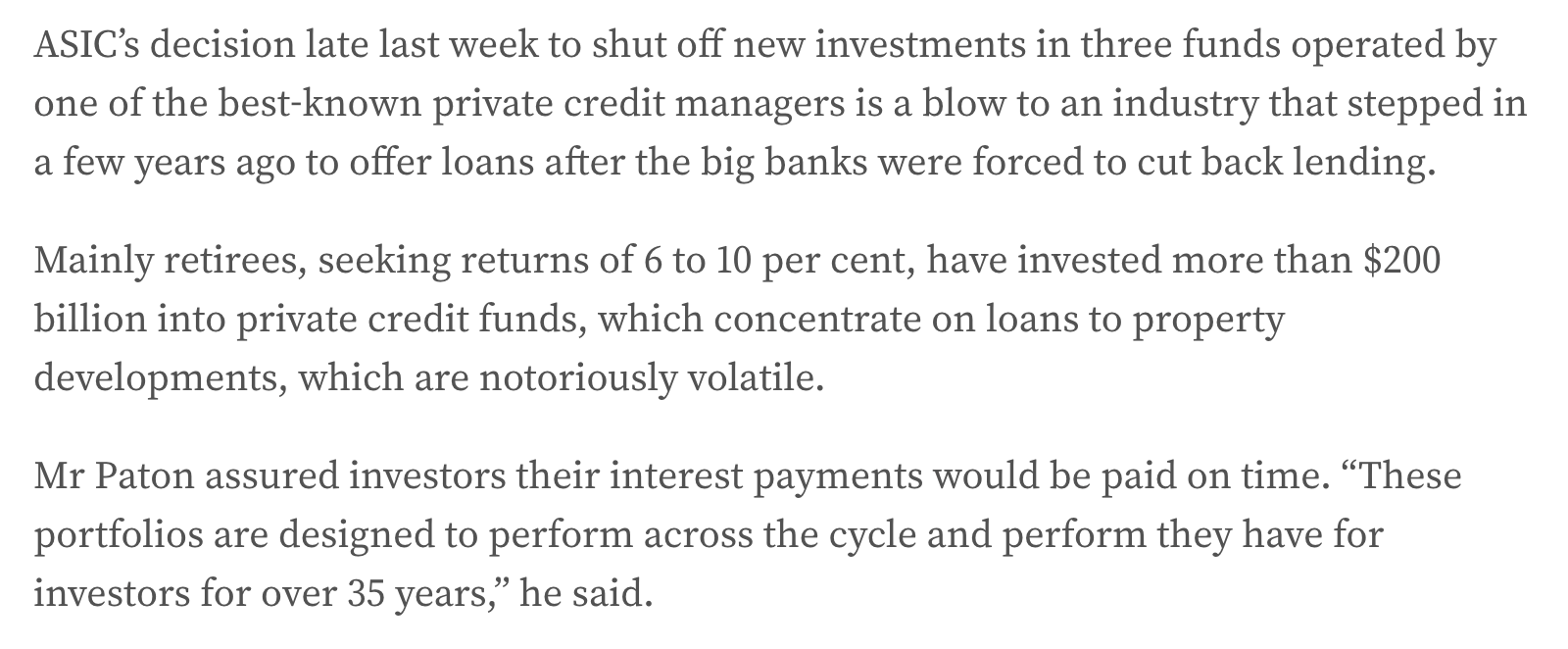TLDR
💣 The mask is off — the financial system’s “safety” illusion cracks when liquidity vanishes and panic begins.
📉 Frozen credit funds reveal the end‑of‑cycle truth: yield hunters become bag holders when “safe” income locks up.
🧠 The 18.6‑year real‑estate rhythm is peaking — euphoric leverage today is tomorrow’s forced liquidation.
⚙️ Survival rule: hold liquidity, think independently, and study cycles — clarity now beats courage later.

This moment is one of those rare times when the mask comes off, and you see how fragile the modern financial system truly is.
Today I want to walk you through something that for most people might look like a small news item, but beneath the surface, it carries the potential to trigger a domino effect across the entire financial ecosystem.
Think of this newsletter not as a piece of commentary, but as a guide to understanding what happens when complacency meets the turning point of a financial cycle.
THE REALITY OF THE NEXT FINANCIAL RESET
Over 100,000 investors in Australia suddenly found themselves unable to access their own money. $11 billion trapped inside three frozen private credit funds run by La Trobe Financial. What was sold as a safe, steady income instrument became a locked gate between retirees and their life savings.

Source: The Nightly
What happened is a reflection of the eternal law of financial cycles:
When we are at the later stages of a long boom > the appetite for yield grows stronger > the imagination of safety shrinks > the illusion of sophistication replaces the discipline of doubt.
This is classic end‑of‑cycle behavior.

The regulator, ASIC, stepped in and halted these funds. According to public statements, regulators suspected that capital from ordinary investors was being channeled into high‑risk property development loans while being marketed as safe income products.
Now think about the irony here. Retirees chasing defensive income ended up speculating in real estate development indirectly — one of the most cyclical and volatile sectors of all.

Source: The Nightly
WHEN SAFETY IS JUST A SALES PITCH
Every investor was shown professional brochures, reassurance letters, and polished phrases like “high quality granular loan assets within highly diversified portfolios.” The kind of vocabulary that gives comfort while concealing risk.

La Trobe Financial Website
Let me translate that to plain English.
Diversified portfolios mean spreading exposure across many loans, but the underlying correlation is still property.
Granular assets mean small loans, but a thousand small holes in a ship still sink the ship.
And high quality simply means they believe the borrowers will pay — until they do not.
This pattern is not new. The same logic fueled the subprime crisis in 2007. Retail investors and even institutions trusted bond ratings and complexity they did not understand because the returns were attractive. When the tide went out, we discovered who was swimming naked. That lesson has not been learned; it has been repackaged.
THE WITHDRAWAL TRAP
Most of these funds are built on long‑term loans to property developers. You cannot recall those loans overnight. Yet the products are offered to retail investors as if they can redeem whenever they choose.
On paper, they are told it may take 90 or 180 days for withdrawals. In practice, that flexibility disappears once the regulators step in or the fund’s internal liquidity buffer runs out. Some of these funds even include clauses allowing redemptions of only 5 percent of units per quarter, meaning a full exit could take years. Think about the chaos that emerges if confidence collapses and everyone requests redemption at the same time.

This is the system the modern investor is trusting — a structure that depends on calm markets to appear functional. The moment volatility enters the arena, transparency vanishes, websites go offline “for maintenance,” and communication becomes damage control.
This is one of the first signs of crisis.
The lesson here is simple: trust structures, not promises. If you cannot understand where your money is, whom it is lent to, and how long it will take to get it back, then you are not an investor — you are a donor hoping for generosity.
THE STAGE OF THE 18.6 YEAR CYCLE
We are currently at the final expansion stage — the manic phase where developers, lenders, and speculators all believe the boom will never end.

That is the stage we are in today. The land market in many developed economies, especially the United States and Australia, has reached saturation levels:
🔥 Rising land prices detached from real income growth
📉 Declining construction activity despite record listed values
💸 Developers depend on refinancing rather than profits
🏦 Central banks pivoting to lower rates to rescue leverage
💸 Growing household debt relative to GDP
🧾 Private credit and alternative lending replacing bank credit

When land prices stop rising, the entire credit pyramid begins to contract from the top.
Private credit funds — like those frozen today — hold loans secured by property values that may soon decline. Once valuations fall, borrowers struggle to refinance, defaults rise, and fund liquidity evaporates. The timing coincidence with the cyclical peak is not accidental; it is the rhythm of history repeating itself.
THE INTERSECTING DOMINOES OF MODERN MARKETS
This story is not isolated. It interlocks with broader global patterns. Let us examine the 2 main forces shaping the next decade.
First, the shift from traditional banking to private credit means risk is moving from institutionally protected layers to retail and shadow lenders. This makes the system more fragile and opaque.
Second, the dependence on perpetual monetary easing by central banks ensures that when debt cycles reach maturity, the only policy tool left is stimulus.
This inflates asset prices further but debases currency value. Savers lose purchasing power even in nominally profitable investments.
